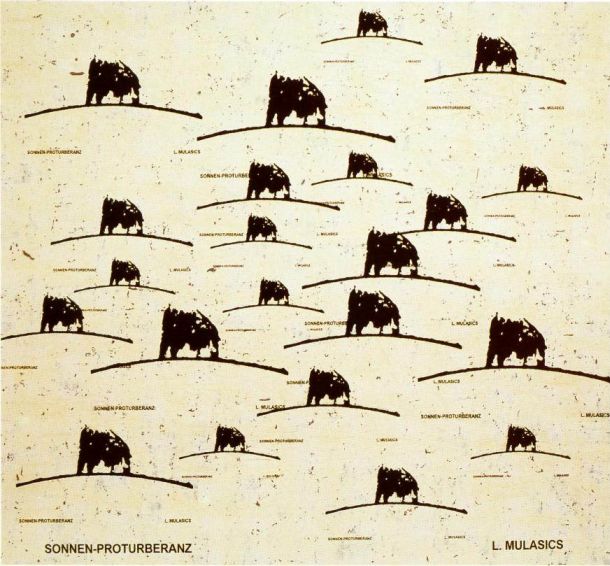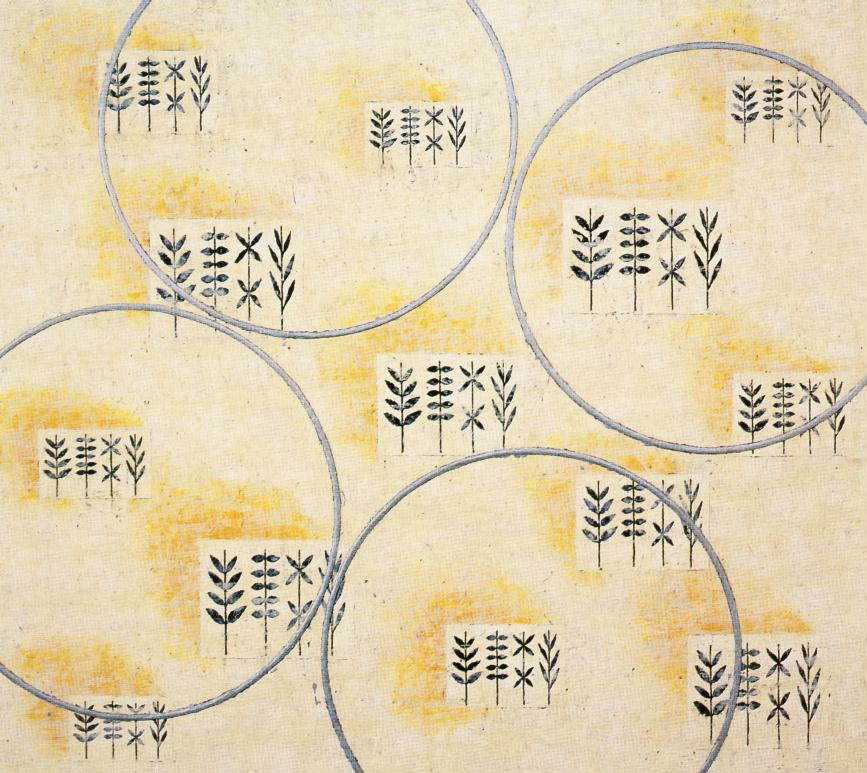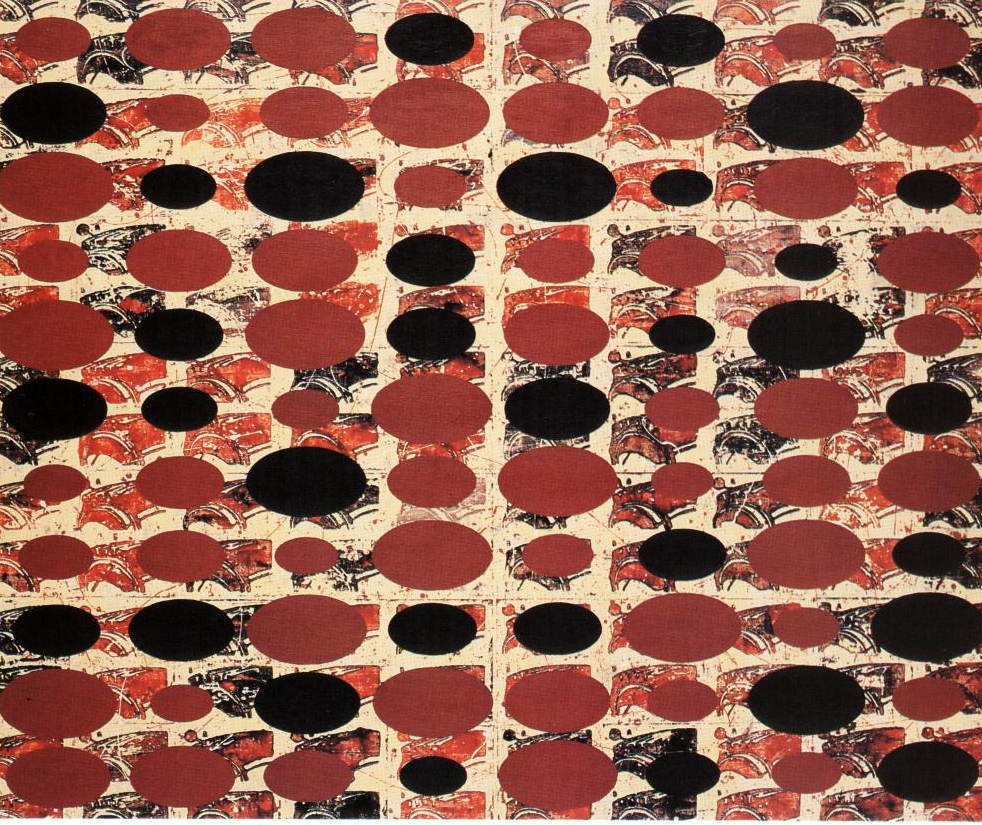The first words, as usual in forewords, are cheerful and
mellow most of the times, like in catalogue introductions. Now, this is
obviously not the case.
There is some remorse to it: this exhibition should
have taken place while he was still living but I always thought there would
be another time to do it so there was no need to hurry. Now there is no
other time.
The other factor which makes it hard is that I
was a very good friend of Mulasics: we had some very good talks smoking
our cigarettes and drinking a few beers and some wine. In his atelier in
the Káli basin, there were blissful and noisy parties, each representing
the peak of that summer. All our friends, relatives and business partners
came together from the neighborhood and from far away. We looked at the
pictures, talked a lot and had a good time. The last of such nights coincided
with a huge summer storm: the sky darkened above Tapolca, thunder-strokes
were everywhere but the sun above us was still shining. It was a beautiful
night even though we had to get round rivers of mud and trees that fell
over the road our way back home. This private merry-making is relevant
only because on the day of the fatal accident in July 2001 I had to drive
from the Balaton to Kiscell. It was real scorcher, the hottest day that
summer, so I thought that neither my old dog nor me was going to survive
the trip. We made it but he didn’t. The following day when I just got back
I wanted to phone him to ask about the usual annual party and I leant that
there was no one to call anymore. 
‘Commemorating exhibition’ is not a good genre.
If the exhibition were commemorating him on the 10th or the 25th anniversary,
it would be more or less neutral. Our approach could be artistic, detached
and analytical and our view would be aided by the many years behind us.
All this is impossible in the case of the present exhibition. Otherwise,
the location is not even suitable for putting huge oeuvres on exhibition,
so any exhibition of this genre is made impossible even if it would been
our aim to put all of his works on exhibition. Luckily, most of his works
are still together in his workshop, nicely put in order; old and new pictures
together with canvases prepared but not painted on. Choosing the pictures,
in the technical sense, was very easy: we want to exhibit pictures
from his most mature periods, new ones, which could not be seen before,
and old ones, which have been recognized as emblematic Mulasics works recently.
If I want to make it sound rhetorical, then this exhibition is a cross-section
paying homage to Mulasics from his recent works. This will not substitute
an exhibition of his oeuvre, but I still feel that I have to try to make
up somehow for the displeasure of not giving him a chance to put his pictures
on display in the museum.
To move away from excuses and commemorating, I
quote here my exhibition opening speech from 1996, which characterizes
the seriousness and the subtlety of our painter:
”Our friend, Mulasics, operates with knowledge.
His craftsmanship as a painter is, no doubt, exceptional and virtuoso but
I don’t wish to talk about it here since those who are interested have
already heard a fine and expert lecture on this topic by Csaba Kozák
at the opening of Pandora’s Gallery, which I could not surpass anyway.
So, let us deal with knowledge, which is a central theme of Mulasics’s
pictures in the form of strange quotations,
He visualizes encyclopedias’ captions, which are,
as we all know, summaries of knowledge. Visualizing knowledge is far from
easy. Even the encyclopedias can do pranks like visualizing the concept
of Pegasus: a horse with wings is drawn. This is where Mulasics starts
too, what is more, he turns it around: paints a horse with wings and then
puts the lexical information there. The horse is a quotation together with
the text containing the knowledge, which forms a picture that is a quote
again. This is what Mulasics is praised for. All this only encouraged him,
so he ventured into a much more dangerous area: even physics diagrams cannot
dishearten him any more. Physics is nothing but the most precise reading
of the real world and nothing can challenge its unpoetical style except
maybe for a tax form. Our artist, Mulasics, is still not backing
but is capable of making a picture out of this solar turbulence diagram.
Solar turbulence is said to be very picturesque indeed if it is not represented
on a diagram, but on a picture taken using either a telescope or a satellite.
You do not need special powers to make a picture out of those, therefore
this does not interest our artist.
What he is interested in is transforming our knowledge
about nature into pictures. Mulasics’s painting locates itself within the
art-nature-knowledge triangle.
István Hajdu
Colorful strings for thoughts for László
Mulasics in present tense, not caring about the present
László Mulasics is an humble-sensual painter
who, since the second part of the nineties, paints purely preconceptualist
paintings. In other words: his pictures are about a painting style that
is not verbalizable but very much near words (just like others write literature).
Mulasics is almost applying the Church-Turning principle, which states
that the problems of mathematics can only be solved with the use of mathematics.
So, P, in a tautological manner, visualizes visual facts. We can say that
he visualizes images relating to themselves with his pictorial skills.
In a different language: he puts down statements which are about themselves.
(A small detour: this is why Wittgenstein’s rigorous asceticism is not
worth paying attention to any more.)
>From another aspect: Mulasics poses the question whether
the subtle membrane separating painting and narrativity can be transformed
into a picture, and what will the result be? We have already seen the answer
in the form of the pictures and we can meditate more about these visions.
The works that are based on repeating a theme reveal the sets of painted
paintings for us. These sets are paintings that form painting itself together,
the picture of painting, the painting about painting.
All this has two - or more - interesting aspects.
One: Mulasics’s sets devour themselves, according to
Hofstadler and Russel, since they are paintings as sets-of-paintings, or
sets as paintings, which is made even more credible by the devotion to
monochromity homogenizing and making the sets more profound. In other words:
the obvious way of using the colors emphasizes the equality of the elements
and, as a consequence, their juxtaposition. Two: the whole is not really
the whole since the superimposed pictures (elements) can create the impression
in the observer that there is possibly more than one layer. We cannot know
- may only hope - that the covered ones are also painted but we only wish
for the real one, the physical reality - in case we issue it as important.
( Let’s be more accurate, we can be sure that there is a painted meaning
‘under’ them since the encaustic technique demands it. ) 
The overlaying, the covering - so the paradox that lies
within the technique of portraying is very interesting indeed. On one hand,
it does virtually visualize devouring oneself and it also, so to say, brings
Epimenides into the picture. The legendary statement of this philosopher
from Crete (everybody from Crete lies) changes its dimension in Mulasics’s
hands: the painter casts the conventional statement saying that every painting
is a picture into oblivion ( We should stop at the tautological sentence
that has just been made for a while to expand it because of Mulasics’s
works: every painted picture is a painting but not every painting is a
painted picture. Florenszkij inspired this little detour)
I have already talked about the theory or referring to
oneself, but I would still go back to it for a moment. The pictures of
Mulasics which are reminiscent of landscapes (or maps) make the thoughts
of Gödel somewhat relevant and definitely deserve a bit of explanation.
The theory of a statement that refers to itself (recursive) manifests in
the still moment of the series called Flood-Ebb Factor or even better in
the red and black Can it Be More?, which means the gist of the set of paintings’
plot is peaking in ambivalence. These landscapes may capture the first
seconds of the catastrophe or the collapse, the moment when the proportion
of the elements forming the picture is changing, the covered part overwhelms
the uncovered one.
These pictures do literally capture and immobilize -
as we are talking about paintings - the narrative making it stop, finishing
it and undoing it. The recursiveness, the self-justification of the plot,
according to its gist, the painting-as-painting principle, undoes and extinguishes
itself transforming into its old shape again: an unstable landscape-illusion
or rather a multiplied perspective or a still-ish genre solely in order
to put the observer again, just like into an infinite loop, onto a road
leading to a catastrophe that would not come about. So, in Mulasics’s silvery
calm way of presentation, apocalypse probably, or even surely, will be
deterred from occurring by calling its name sighing.
The treasury of information about Mulasics and his art, which includes the techniques he used together with all of his motifs and themes including their cultural-historical relevance.
Excerpts from the Mulasics encyclopedia:
Encaustics - (Greek ‘enkausis’ - burn into) It was used
in the ancient Greek architecture for coloring ornaments and sculptures
and also in Egypt (in the Roman age) for making mummy portraits. In Munich,
during the first part of the 19th century, attempts were made to renew
wax-painting. Mulasics found this ancient technique at the end of the 1980s.
The hot mixture of melted wax, resin, terebenthene and paint is put on
the canvas in a liquid form and becomes stiff fast. If you repeat this
process several times, it results in a soft and silky surface. The colors
and the captured light glows dimly from under the transparent layers.
Motif - an archaic sign, a found object, a photo, an
illustration of natural science, an astronomical equipment, an excavation
map, a diagram, a graph, an engraving or an impression of a plant etc.
A formally transparent pattern, tool or medium striking in its simplicity
or complexity freely chosen from encyclopedias and books of knowledge,
from the treasuries of human knowledge of thousands of years themes of
roving: Deer a symbol of the sun, an image of Christ, the animal symbolizing
melancholy in the iconography of the Renaissance Griff: a mythical animal,
has the body of a lion but the head, the wings and the seres of a eagle.
In the Greek mythology it is the symbol of the sagacious mind as the sacred
bird of Pallas Athene. In the Christian iconography the eagle is a symbol
of Christ. Dog is the first animal which was domesticated by humans, it
is a symbol of fidelity and vigilance and is further associated with melancholy
from the four temperaments. Horse, symbolizes the hidden and indestructible
nature of things in Buddhism, also a symbol of the sun. In psychoanalysis
it expresses the subliminal, desires and the time. Giroscope (pendulum
of Foucault) A tool invented to prove that the earth is turning around
its axis, it is also used when studying bodies in turbination. Laurel a
trailing pant symbolizing immortality and eternity. Bridge a structure
whose function is to connect to banks or shores and is also used
as a symbol of the link between earthly-sensual and heavenly-suprasensibile
life. Can it be more?1998. Interference: a physical phenomenon occurring
when different waves (water, sound, light, radio etc.) meet at the same
time in the same place / spot. Changing Variables 2001, No title 2001.
Transposition (transfer) Transcription (rewriting, reworking)
The process of taking a motif out of its original surroundings or context
leaving it fundamentally intact while otherwise and putting it into a new
combination of form. Transcription of photographs, objects and designs
into painting or wax. Paradox In the title, a message interpreted or encrypted
using a stunning word-group. A well-known method in Zen-Buddhism where
you can reach the enlightenment, or moments of clairvoyance with the help
of strange associations, unnerving mysteries or embarrassing humor. The
Conquering Captive 1987; Deep in the Terraces 1990;
Lone Horsemen 1995. 
Theme Themes relating to geometry and astronomy are much
honored among the ancient artes liberales just like agriculture, hunting,
pottery, artisanship, fine arts and architecture among the artes mechanicae.
We can see Mulasics’s intention to depict the objective rule-governed reality
defined by the modern sciences (physics, astronomy, chemistry, geology,
biology) or the technical sciences (industry, architecture, transportation,
agriculture) in subjective and poetical transcripts:
Fragrant Valley -series; Sonnen-Protuberanz 1996; Repartition
of Velocity 1996; Viscum album-series 1999.
The form / shape / pattern of time An approach where
a possible role / mission of the artist is to discover the complex forms
of time and to reconstruct it in his own particular way - very much similar
to the ideas and thinking of George Kubler. The finding taken out from
the flow of time is conserved in amber or resin. Sometimes this finding
grows into a arabesque which presents us with the recollections of its
sample’s original meaning: Viscum-album -series. Otherwise the chosen motif
can be seen through the dense web of abstract forms or geometrical objects,
or the picture floats in the air showing itself multiplied in different
sizes. Real or imagined creatures inhibit the final work of art, it is
kept moving or it is deterred from spreading everywhere by non-existent
machines. „... the artist cannot create solely according to his own will:
he is strictly bind by the sequence of events from the past. These chains
are invisible to him and they restrict his movements. He does not even
know that these chains gain their power from the events of the past behind
him.” (Kubler) This oeuvre, which can also be interpreted as a strange
encyclopedia and suggests a polyhistor-like approach, creates a new universe
parallel to the real one.
